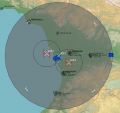DCS Reference/Dynamic Weather: Difference between revisions
Jump to navigation
Jump to search
m (→�) |
m (→�) |
||
| Line 82: | Line 82: | ||
=== Long winds === | === Long winds === | ||
<gallery> | |||
TriSnowParameters.png|Parameters for a calm snowy day. | |||
PatchySnow.jpg|Mission editor appearance. | |||
</gallery> | |||
== Weather editing with CombatFlite == | == Weather editing with CombatFlite == | ||
[https://www.combatflite.com/ CombatFlite] | [https://www.combatflite.com/ CombatFlite] | ||
Revision as of 18:58, 25 August 2019
Tools and workflow
To create good, deliberate dynamic weather systems, you absolutely need the following:
- A good zip manipulation tool — anything that lets you seamlessly browse, extract, and add to the file structure of a zip file.
- Notepad++ or a similarly competent text editor. No, not notepad.
- A conversion tool for angles and distances (Windows 10's built-in calculator does this well enough).
- Patience.
- Patience.
- Patience.
You need these because the basic flow of weather creation is one of:
- Creating a dummy mission where you place trigger zones as a first approximation of the pressure fronts.
- Extracting the “mission” Lua file from the dummy .miz.
- Opening the mission file in your text editor of choice.
- Copying the trigger zone coordinates (and possibly sizes) to a weather parameters.
- Re-inserting the edited mission file into the .miz.
- Reload the mission.
- Preview, hate actual result.
- Start over.














